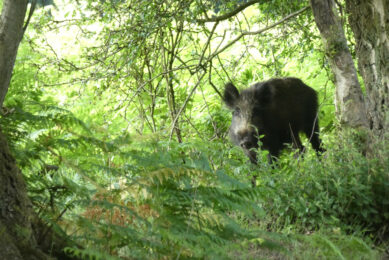Pigs in Paris – 42nd JRP nutrition research review
Although it sounds surreal, French capital Paris was the stage for the Journées de la Recherche Porcine (JRP – Pig Research Days) held for the 42nd time in early February. All aspects of pig production were covered, such as management, health, housing, etc. This article summarises the nutrition related research subjects.
By Dick Ziggers
The JRP event is a cooperation between French public research institute INRA and the private French Porc Institute IFIP – a cooperation that already lasted for 42 years. The presentation sessions remain dominant, but more than 750 scientists and technicians from the pig industry also have the opportunity to exchange work experiences, which often leads to new partnerships and extensions to enterprise applications.
Effect of faba beans in the diet
Two experiments were conducted to evaluate the effects of faba bean (Vicia faba L.) type and incorporation rate in phase 2, growing and finishing diets on pig performances. In a post-weaning experiment, 360 barrows and gilts weaned at 28 d of age were allocated to one of five dietary treatments. Piglets were housed at 15 per pen. After a standard phase 1 diet, each group was given ad libitum a phase 2 diet including a white-flowered and low in tannins faba bean (cv. Victoria) at a 10% or 20% incorporation rate, or a coloured-flowered, rich in tannins type (cv. Marcel) at the same rates, or a control diet without faba bean. All diets were iso-energetic and contained the same levels of amino acids. From weaning to day 42 after weaning, piglets had similar DFI, ADG, and FCR.
In a fattening experiment, 150 pigs were grouped (five pigs per pen), and were assigned to one of the five dietary treatments. Higher rates (20% and 35%) of the same faba beans were tested in the growing and finishing diets. During the growing phase (32 to 59 kg), diets resulted in equivalent daily feed intake (DFI), average daily gain (ADG) and feed conversion ratio (FCR).
For the finishing phase (59 to 114 kg), an interaction between the diet and sex effects on DFI occurred. Gilts with 35% white flower beans in their diet ate less than gilts with 20% of these beans in the diet (2.72 vs. 2.96 kg/d). Meanwhile, barrows had no difference associated with dietary treatment. When averaging DFI, there was a main effect of sex. Nonetheless, no diet, sex or interaction effect was found significant on ADG and FCR.
With these results, it can be concluded that in amino-acids balanced diets, the two types of faba beans can be used at respectively 20% and 35% inclusion levels in phase 2 and fattening feeds.
Fermentable fibre and piglet performance
Dietary fibre after weaning could be an alternative to the use of antibiotic growth promoters. This experiment carried out at INRA and IFIP, aimed to evaluate the effects of fermentable fibre on piglet performance and health during post-weaning. Sugar beet pulp and soybean hulls were introduced into fibre (F) diets. Diet F and a control one (T) were compared during the first age period. For the second age period, taking into account the diet received in first period by piglets, four combinations were considered for feed treatments: TT, TF, FT and FF.
Specific effects of fibre according to husbandry conditions were also evaluated on piglet performance and health status using optimal or unsanitary husbandry conditions. Unsanitary conditions led to poorer piglet performance and health status, predominantly during the first age period. The reduced daily gain appeared to be due to the decrease of feed intake at IFIP, while it was hypothesised at INRA that a lower digestion and/or absorption of nutrients occurred.
During the second age period, performances were similar indicating that the previous period led sufficient time to adapt to a poorer environment. The effects of fibre did not depend on husbandry conditions. Whatever they were, fibre improved daily gain during the first age period, while during the second age period, daily gain and feed efficiency were decreased by fibre; fibre also increased transiently diarrhoea frequency. No effect of fibre on plasma haptoglobin levels was detected.
Fibre and digestibility
The influence of complex weaning diets was studied in pigs weaned at 28 days of age. The diets differed mainly in protein digestibility of their ingredients, fibre level and solubility. Effects were studied on the characteristics of the gastrointestinal tract and the resulting true digestibility and endogenous losses of amino acids.
Four diets were formulated: a control diet containing digestible protein with a low fibre level; diet 2 with less digestible protein and a low fibre level, and diet 3 and 4 with less digestible protein and insoluble or soluble fibre. The diets were fed for two weeks to 32 piglets.
Dietary indigestible protein led to an enlargement of colonic crypts and to elevated pancreatic weight and trypsin and amylase specific activities.
Dietary fibre increased the weight of gastric tissue and of intestinal contents, jejunal crypt area and reduced the specific activities of maltase, sucrase and aminopeptidase N in the jejunum.
Soluble fibre stimulated ileal mucosa development but reduced pancreas enzymes total activities.
Despite the decrease in enzyme activities, the enrichment of a diet based on peas in soluble or insoluble fibre improved the true digestibility of amino acids without significant increase in endogenous losses. These results suggest that fibre may induce a non enzymatic digestive adaptation to plant derived feeds in the weaned piglets.
Predicting individual requirements
The objective of a combined Brazilian/Spanish/Canadian study was to develop and evaluate a mathematic model able to estimate the daily nutrient requirements of individual growing-finishing pigs. This work is part of the development of precision feeding techniques allowing the right amount of feed with the right composition at the right time to be provided to each pig in the herd.
The model includes an empirical and mechanistic component. The empirical component estimates daily feed intake (DFI) and BW based on individual pig information collected in real time. The mechanistic component estimates the optimal concentration of amino acid that must be offered to pigs to meet their requirements.
The empirical component results indicate that the DFI and bodyweight (BW) trajectories of individual pigs fed ad libitum could be predicted one day (DFI) or seven days (BW) ahead with a mean absolute percentage error of 12% and 2%, respectively. The mechanistic component estimates the optimal lysine to net energy ratio with reasonable between-animal (CV = 7%) and over-time variation (CV = 14%). Thus, the nutrient requirements estimated by the model are animal and time dependent and they follow in real-time the individual DFI and BW growth patterns.
Tryptophan requirement in piglets
There appears to be no general consensus concerning the tryptophan requirement for piglets, expressed relative to lysine on a standardised ileal digestible basis (SID Trp:Lys). Different Trp requirement recommendations appear to exist between Europe and the United States. A meta-analysis was performed to estimate the SID Trp:Lys ratio, which maximises performance of weaned piglets between 5 and 25 kg of body weight. A database comprising 130 trials on the Trp requirement in piglets was established. The nutrient composition of all diets was calculated using information of feed ingredients used in each trial. Among all trials, only 39 trials which were designed to express the requirement relative to Lys (i.e., Lys was the second limiting factor in these trials) while testing at least three levels of Trp, were considered in the meta-analysis.
The model used is an important factor of variation of the estimated requirement: the SID Trp:Lys requirement in piglets was estimated at 16.5% with the linear-plateau model, at 22% with the curvilinear-plateau model, and at 26% with the asymptotic model. There were no indications that the Trp requirement was affected by the geographical origin of the trials.
Comparing boars, barrows and gilts
Growth performance, carcass quality, behaviour and general condition of crossbred boars, barrows and gilts were compared from a batch of pigs fed ad libitum and group-housed both during post-weaning and the fattening periods. Pigs were all slaughtered on the same day.
Between 28 and 63 days of age (post-weaning period), growth performance was not significantly influenced by the gender. Between 63 and 152 days of age (fattening period), daily feed intake of boars was 11% lower than that of barrows (2.41 vs. 2.70 kg/d) whereas their average daily gain was similar (1,056 g). Consequently, feed conversion ratio was 14% lower for boars and their carcass was leaner. Gilts’ performance and carcass leanness were intermediate between those of boars and barrows. According to simulations performed with the InraPorc software over the 25-116 kg body weight range, the digestible lysine requirement per unit of net energy was on average 0.1 g/MJ higher for boars than for gilts and barrows. Barrows were less active than gilts and boars and had more leg problems at the end of the fattening period. Boars presented higher lesion scores (scratches, bite marks) during the first six weeks and more social behaviour. Investigations showed that gilts were more interested by pen features than by other pigs.











